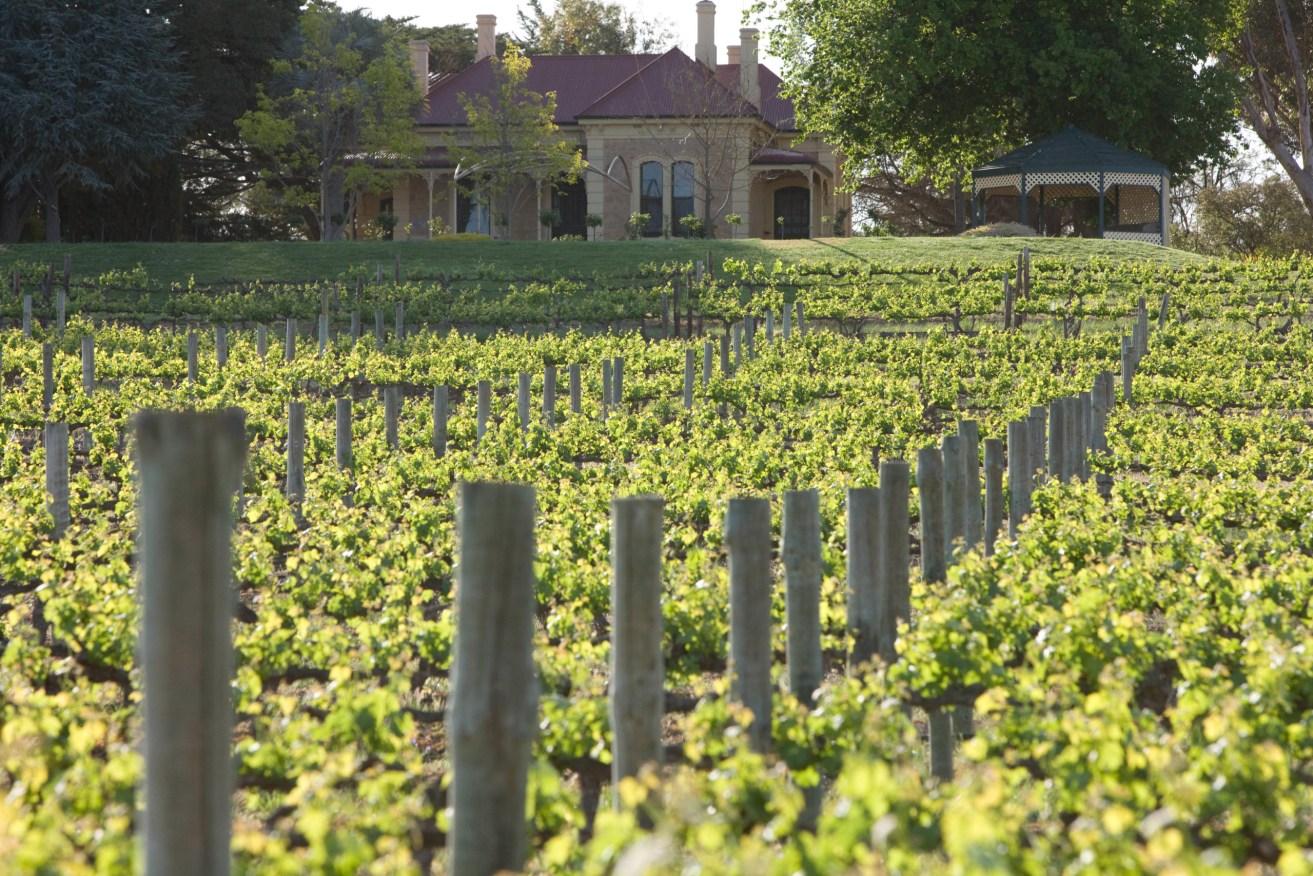Penfolds reviews: What’s in a name?
After six decades of honourable public recognition, a key link in the Penfolds story has gone missing. Our wine writer explores why, as he reviews the latest Penfolds releases – from the relatively accessible to the super-premium Grange.


The historic Kalimna Homestead and vineyards in the Barossa.
All the usual suspects were there at the recent annual Penfolds show and tell.
Critics, writers and journalists from around the country arrived in droves at the Kingsford homestead in the Barossa. The tasters, including this writer, dutifully sipped and scored through the new release lineup, dramatically called “The Australia Collection 2021”, their responses eagerly awaited by the Penfolds marketing team, wine publications and loyal collectors keen to top up their cellars with the highest point scorers.
And so, too, appeared the regular lineup of new-release wines, from the latest Grange, of course, to the prosaic Bin wines with familiar numbers like 389 and 707, to lesser-known tags such as 798 (aka RWT Barossa Valley Shiraz), and the much-loved and more accessibly-priced shiraz Bins 128 and 28.
Confused already? These were originally the simple storage identifiers in the Penfolds cellars at Magill and Nuriootpa, before they became brand names in their own right. Even Grange has its number, Bin 95, though only the nerdiest of Penfolds pundits would refer to it as that. Bin 389 forged its reputation once it became known as “Baby Grange”. Bin 128 is a regional Coonawarra Shiraz, Bin 138 a GSM-style Barossa blend, and so on.
Among them is the much-loved Bin 28, which has always been called, or co-labelled, Kalimna Shiraz. For many, it has been the first, and often the most enduring, experience of the Penfolds story. After all, it costs just a fraction of the big guns – this year $50 compared to $950 for Grange or $650 for Bin 707 Cabernet Sauvignon.
Penfolds’ own regularly updated record of tastings of every single wine it’s made, a densely packed book titled The Rewards of Patience, stated in its sixth edition that Bin 28 has “universal appeal”, having “established a strong reputation as an authentic Barossa-type red”.
“Today it is regarded as an Australian classic, valued for its integrity as a maturation-style fine wine and suitability as a fresh, early drinking style for many different occasions,” Rewards of Patience archivist Andrew Caillard wrote.
But something has changed this year. No longer does that magic name Kalimna appear on the label of the new-release 2019 vintage Bin 28 Shiraz. After the 61st vintage of this label, its absence is a major milestone, and one that has gone virtually unremarked.
The obvious question is why has this slice of South Australian wine heritage been shelved? And does this mean that this vineyard centrepiece of Penfolds history has gone as well?
Not at all, says chief Penfolds winemaker Peter Gago. No way. But it does reveal a saga worth recounting, and brings about a certain amount of truth-telling along with that.
Kalimna is the name of a prized vineyard property in the northern Barossa’s Moppa district. It was first planted to vines between 1888 and the early 1890s by wholesale grocers D and J Fowler, who also had jam and preserve-making facilities in Nuriootpa. They had bought the 900 acres of peppermint scrub to supply wood for their factory furnaces.
The Fowlers named their property Kalimna, which reportedly translated from the Indigenous language of the area to mean “pleasant view”. As an aside, a nearby accompanying Penfolds vineyard, Koonunga (Hill) supposedly translated to “boring view” and it even has been written that it could also mean “dung heap” or “place of excrement”. But we won’t go there.
It’s not because of any embarrassment, but more to eliminate any confusion
Penfolds bought Kalimna from the Fowlers in 1945, and the first Shiraz to carry the Bin 28 tag was made in 1959, making it among the first of the company’s bin range wines. The early Bin 28s were single Kalimna vineyard Shirazes, but during the latter half of the 1970s, as its popularity grew, the wine became a multi-regional SA blend of estate-owned and independent grower-bought fruit from mostly the Barossa, McLaren Vale, Clare Valley, Langhorne Creek and Padthaway, crafted ever since to “showcase warm-climate Australian Shiraz, ripe, robust, and generously flavoured”, according to Penfold’s own winemaking team.
This multi-regional approach to one of its larger-scale fine-wine productions fits succinctly into Penfold’s over-arching mantra to produce single block, single vineyard, single region and multi-regional wines.
And for Gago, the dropping of the Kalimna trademark from the front label of Bin 28 is more than appropriate – a move to be more transparent about the wine’s wide range of source vineyards and not trade on history alone.
“It’s not because of any embarrassment, but more to eliminate any confusion,” Gago says. “It’s a great example of a warm-climate, multi-regional South Australian Shiraz.
“In the day it was purely Kalimna vineyard, but nowadays we share the love with any area that offers that character.”
While the name may have been dispatched from its wine’s frontispiece, and before it perhaps disappears further from the history books, it’s worth noting that this very same Kalimna vineyard has had an envious track record.
Even before the first Bin 28 was created, the fruit had become prized by the legendary Penfolds winemaker and creator of Grange, Max Schubert. After just the first two vintages of Grange, the 1951 and ’52, which sourced fruit from Magill Estate and a Morphett Vale vineyard, Kalimna entered the mix, a unique Cabernet Grange in 1953 made entirely from a famous section of the vineyard known as Block 42.
Author Nicholas Faith wrote in his 2002 book Liquid Gold: Schubert ranked the pure Cabernet from Kalimna produced in 1953 as “one of the best Grange style wines we ever made”.
Andrew Caillard notes from that year on there was uninterrupted use of Kalimna fruit in Grange, and hence the term “Mother Vineyard” was attached to it.

Peter Gago
Three Jimmy Watson Trophy winners in those early days, 1964, 1966 and 1968, came either all or predominantly from the site. The often-cited “greatest Australian wine ever made” – the Penfolds 1962 Bin 60A Coonawarra Cabernet Sauvignon/Barossa Shiraz claret blend – included Kalimna fruit.
The first Bin 707 came from the vineyard’s elite Cabernet block. Many special release and Cellar Reserve Penfolds wines come off the Kalimna vines.
And slow-track but fast-forward to the latest releases and the Bins 138, 389, as well as St Henri, RWT and Grange all tap into this remarkable resource, as well as two inaugural “Superblend” Cabernet Shiraz wines. Even Penfolds’ adventurous move to make Californian reds and blends of them with South Australian components include Kalimna fruit, both via clones of the vineyard’s original vines being having transplanted in America in the late 1990s as well as Barossa Shiraz in the final make.
The importance of the vineyard to the Penfolds story remains as strong as it ever was, Gago says.
“With Kalimna we can’t forget where we came from, and we can’t forget that those grapes go into the very best of our very best wine,” Gago says.
“We attach a lot of emotional energy to it. And we are doing everything we can in the vineyard to preserve its legacy.
“It is very Penfolds in every sense, and I don’t think we would ever walk away from Kalimna.”
The new Penfolds releases will go on sale on Thursday, August 5.
TASTING NOTES

Penfolds Bin 28 Shiraz 2019
Various SA regions / 14.5% / $50
Sourced from mostly McLaren Vale (44%) and next in line Barossa (23%) with additions from Padthaway (13%) and Wrattonbully (5%), this shows just how multi-regional and multi-vineyard this wine has become. It has an immediate traditional Penfolds feel for warmer regional styling, with all the dark fruits, suggestions of bitter chocolate, and wafts of florals as you swirl and sip. Simply lovely rich and ripe Shiraz with a vintage note of more complex savoury, earthy characters.

Penfolds Bin 389 Cabernet Shiraz 2019
Various SA regions / 14.5% / $100
A wine for Penfolds’ true believers. “Claret” for the modern era, and once again stating its case for multi-regional styling. Fabulous from the first whiff, with so much going on in its complex expression that begins with Cabernet’s aromatic herbal notes, then reveals some meatiness and charcuterie character, mocha of course, and delicious little pokes of sweet plum bringing the Shiraz fruit into focus. The synergy of the blend becomes singular, wrapped up in a mouthful of integrated tannins. All-round excellence.

Penfolds RWT Bin 798 Barossa Valley Shiraz 2019
Barossa Valley / 14.5% / $200
Arguably the most dramatic of the collection’s releases this year, this Shiraz is all-stops out, turbo-charger on, power chords played, yet with precision and accuracy delivering an exciting aromatic introduction then sustained and reverberating interest. Think of the most enticing bakery smells of berry tarts, fruit cake, then the charry notes of a wood oven morphing into the French oak influences of cedar, capers and sandalwood – all of which the Penfolds team has noted as well in their own tasting assessments. Indulgent and most convincing.

Penfolds Bin 707 Cabernet Sauvignon 2019
Various SA regions / 14.5% / $650
The Penfolds winemakers note quite clearly that the 2019 vintage across many of its wines has delivered what they call a “savoury cloak”, and here it is clearly exposed. Note too that this vintage is sourced out of four SA regions, McLaren Vale contributing 41% and Coonawarra 36%, with Barossa Valley and Padthaway adding the rest. In the first instance, this Cabernet is less exuberantly aromatic in the leaf and cassis fruit department than its Bin 407 sibling, and more to do with blue florals, black olives, with maritime notes of iodine and seaweed. Its 100% new American oak maturation is soaked right up so the sweeter chocolate and spice feels add a comfy familiarity. Deep contemplation required here.

Penfolds Grange 2017
Barossa Valley/McLaren Vale / 14.5% / $950
A cooler than average season in this vintage’s two source regions, Barossa Valley and McLaren Vale, has resulted in a more aromatic Grange than usual, which adds to its already established complex expression. We see here meaty and herbal elements rising to the fore in a rich, gastronomic style with plenty of Grange character on show: formic notes, dark soy and licorice with vanillin oak integration, while the mouthfeel is most appealing, the expected tannin coating delicately integrated. A drink-now style Grange, yet with all its cellaring potential intact.




